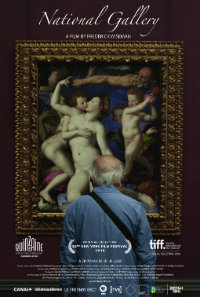Museum Hours: Wiseman’s Tour through London’s Famed Museum
 If you’ve never been to The National Gallery in London, England, one of the most preeminent museums in the world, then Frederick Wiseman’s latest documentary, the simply named National Gallery, will appear to be something of a soothing, handsomely photographed introduction. Like a phantom floating through crowds and into behind-the-scenes operations, there’s even a bit of priceless perspective to be had on a tour, here presented as the learning experience many take for granted when they’re strewn haphazardly through the landscape of privileged youths. As solemn and well-thought as this documentary usually is, at a running time of three hours and without much more of a thrust than an all-encompassing experience of the renowned establishment, attentions spans may teeter in and out of sharply honed focused as our consciousness’ are restlessly pulled into the works on display themselves, tuning out the hard work of the tour guide’s learned artifice.
If you’ve never been to The National Gallery in London, England, one of the most preeminent museums in the world, then Frederick Wiseman’s latest documentary, the simply named National Gallery, will appear to be something of a soothing, handsomely photographed introduction. Like a phantom floating through crowds and into behind-the-scenes operations, there’s even a bit of priceless perspective to be had on a tour, here presented as the learning experience many take for granted when they’re strewn haphazardly through the landscape of privileged youths. As solemn and well-thought as this documentary usually is, at a running time of three hours and without much more of a thrust than an all-encompassing experience of the renowned establishment, attentions spans may teeter in and out of sharply honed focused as our consciousness’ are restlessly pulled into the works on display themselves, tuning out the hard work of the tour guide’s learned artifice.
For those first coming into the Wiseman fold, a documentarian with a stunning forty seven years already working within the medium (and without any signs of slowing, with last year’s At Berkeley still fresh in minds, and with another project already well underway as his latest hits theaters), National Gallery, though without a point more than as a physical document of what a visit to one particular museum would feel like, is generally the detached tone the filmmaker generally utilizes.
Like an actual visit to a museum, we’re left to free associate, and everyone is sure to have greater instances of attraction here, though the expert lectures from several knowledgeable tour guides do happen to be the most arresting moments. Assays into the religious and specific Biblical allusions are important for our contextualization, so discussions involving Samson and Delilah or a Bellini painting feel like the accessible and academic morsels that we miss out on drifting on our own, without such a guide. Likewise, discussions about how to appreciate the medium, the painstaking restorations, and even the complicated and fragile museum budget paint a portrait that a mere museum visit would never deliver.
National Gallery is also reminiscent of Jem Cohen’s 2012 Museum Hours, a drama dressed as a documentary about a museum guard’s slowly developing relationship with a vibrant museum visitor that enriches both of their lives. We’ve no such focal point here, though a favorable discussion about the spirituality evident in Da Vinci’s works explain his relevance today (which translates into profit for the museum during an exhibition) and speaks to the power these works still hold today.
The nature of experiencing art in the solemn, revered space of the museum continues to inspire creativity in all forms, as evidenced by a woman’s sharing of her own poetry, which transcends into a discussion about the limitations of language, with a shout out to Yeats’ argument about how the description of a thing can never truly engender the essence of that thing. “The meaning is in the gap,” becomes the wisest statement of the film, encompassing not only the limitations of language but even of cinema as well, both ways we record the world that are mere reflections or shadows. Ending on a note of whimsical fancy, two ballet dancers perform through the emptied rooms of the National Gallery, their energy somehow seeming to be right at home.
★★★½/☆☆☆☆☆


